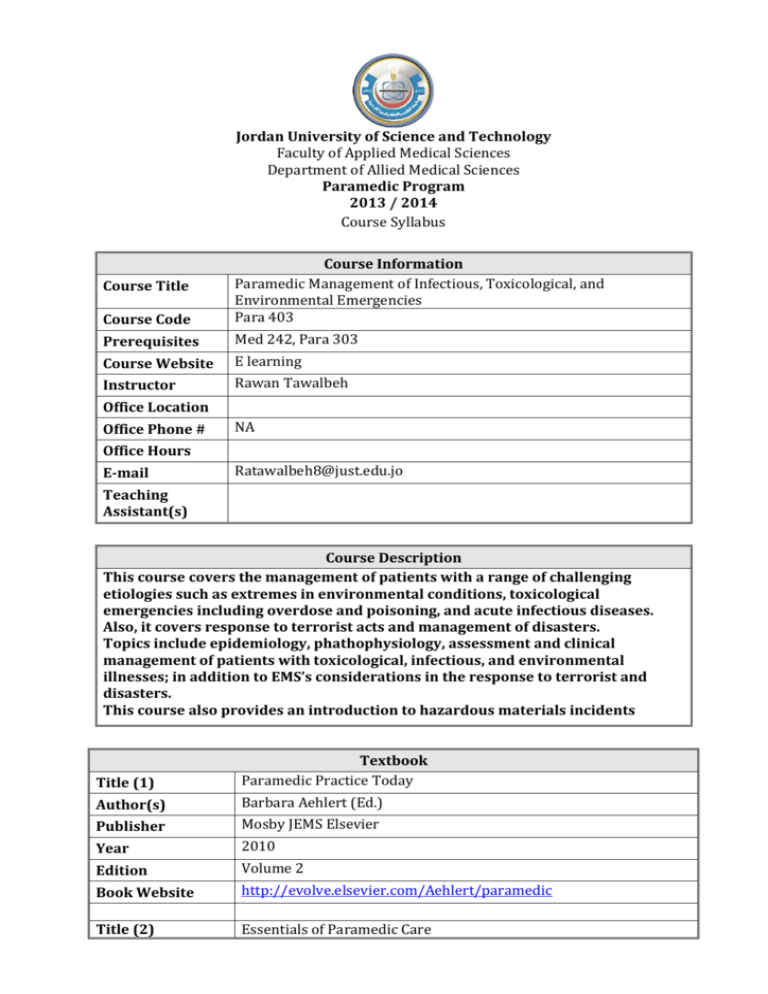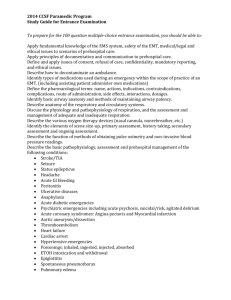PARA 403 e-Syllabus - Jordan University of Science and Technology
advertisement

Jordan University of Science and Technology Faculty of Applied Medical Sciences Department of Allied Medical Sciences Paramedic Program 2013 / 2014 Course Syllabus Course Code Course Information Paramedic Management of Infectious, Toxicological, and Environmental Emergencies Para 403 Prerequisites Med 242, Para 303 Course Website E learning Instructor Rawan Tawalbeh Course Title Office Location Office Phone # NA Office Hours E-mail Ratawalbeh8@just.edu.jo Teaching Assistant(s) Course Description This course covers the management of patients with a range of challenging etiologies such as extremes in environmental conditions, toxicological emergencies including overdose and poisoning, and acute infectious diseases. Also, it covers response to terrorist acts and management of disasters. Topics include epidemiology, phathophysiology, assessment and clinical management of patients with toxicological, infectious, and environmental illnesses; in addition to EMS’s considerations in the response to terrorist and disasters. This course also provides an introduction to hazardous materials incidents Title (1) Textbook Paramedic Practice Today Author(s) Barbara Aehlert (Ed.) Publisher Mosby JEMS Elsevier Year 2010 Edition Volume 2 Book Website http://evolve.elsevier.com/Aehlert/paramedic Title (2) Essentials of Paramedic Care Author(s) Publisher Year Edition Book website Bryan E. Bledsoe, Robert S. Porter, Richard A. Cherry Brady 2007 2nd Edition NA Title (3) Author(s) Publisher Year Edition Book website Basic Infection Control for Health Care Providers Mike Kennamer Thomson Delmar Learning 2007 2nd Edition Other references Hand outs. Article provided by the course instructor: Barbera, J.A., Macintry, A. (1996). Urban Search and Rescue. Disaster Medicine. 14(2): 399-409. Assessment Assessment First exam Second exam LAB Expected Due Date Percentage 20% 20% 20% Final exam (theory) 27%% Final Practical 13% Total 100% 1. 2. 3. 4. 5. 6. 7. Course Objectives This course will cover infectious diseases in the prehospital environment. This course will cover infection control principles in the prehospital environment. This course will cover common toxic and overdose emergencies and its management in the prehospital environment. This course will cover concepts of Hazardous Materials and its management in the prehospital environment. This course will cover extreme environmental emergencies and its management in the prehospital environment. This course will give an introduction about disaster management and its prehospital emergency care considerations. This course will encourage the engagement of evidence-based practice. Percentage 15% 15% 15% 15% 20% 10% 10% Teaching & Learning Methods Objectives of the course will be achieved through class lectures / presentations, and case studies: Learning by examples. Skills as founded in the theoretical material will be demonstrated and discussed in a laboratory environment over the semester. Students are highly encouraged to attend ALL lab hours and participate effectively. Once a student misses lab hours during a week, he or she can make up with the other lab hours of that same week with the arrangement with the course coordinator. As possible, a guest speaker will be invited to weigh his experience in. 'E learning' will be integrated. Students are highly encouraged to participate in the content of course subjects by preparing flash cards of assigned subjects. You are responsible for all material covered in the class. Your engagement during lectures is essential; discussions are highly encouraged. Please communicate any concerns or issues as soon as possible either in class, by phone or by E-mail. Teaching duration: Duration: 15 weeks, two lectures per week. Lectures: 22 lectures, 60 minutes each, does not include exam days and revisions. Guest speaker: Possibly 1 lecture. Laboratory: Two hours per week. Total of 7 labs distributed over the semester, corresponding with the material. Assignment: Flash Cards In the first day, students will be assigned into groups; each group will take the responsibility of four (4) infectious diseases. Each group must prepare flash cards for each infectious disease and make copies for the rest of their classmates. The cards mush contain the following: The causative agent, body systems affected and potential secondary complications, routes of transmission, susceptibility and resistances, signs and symptoms, patient management and protective measures and immunization. The goal of this assignment is to ease studying infectious diseases despite their numerous quantities. Each group is responsible on submitting these flash cards by Sep.30, which is the day/week of infectious disease in this course. This assignment weighs 5% of the total grade. Diseases of concern: AIDS Anthrax Avian Flu Botulism Chickenpox Clostridium difficile Escherichia coli Hepatitis A Hepatitis B Hepatitis C Hepatitis Non-ABC Influenza Lice Measles Meningococcal Meningitis Mumps Gonorrhea Staphylococcus-aureus (MRSA) Pertussis Plague Pneumonia Rabies Rubella Croup Scabies Severe acute Respiratory Syndrome (SARS) Gastroenteritis Syphilis Tetanus Tuberculosis Sinusitis Hantavirus Food Poisoning Learning Outcomes: Upon successful completion of this course, students will be able to Reference(s) Related Objective(s) Handouts Understand and discuss the etiology of common infectious 1 diseases and its pathophysiology. Understand and discuss infection control considerations for 2 prehospital emergency care. Demonstrate an understanding of the up-to-date emergency 3 management for infectious diseases and inflammatory responses incidents in the prehospital environment. Understand and describe the etiology and pathophysiology of 4 selective environmental emergencies. Demonstrate an understanding of the up-to-date emergency 5 management for extreme environmental incidents. Understand the medical issues associated with disaster management and its considerations. Understand the rules and responsibilities of EMS during disasters. 6 7 8 9 10 11 Understand the medical consequences of selective disasters (earthquakes, floods, and nuclear disasters) and their EMS management. Understand and discuss the etiology of common toxic emergencies and substance overdose and its pathophysiology. Demonstrate an understanding of the up-to-date emergency management for toxic and substance overdose/abuse incidents. Understand the concepts of Hazardous Materials incidents and its management. Useful Resources Scientific articles in peer-reviewed journals in EHS, disaster management, and prehospital care. Course Content Week 1. a. (Sep. 22) 1. b. (Sep. 24) 2. a. (Sep. 29) 2. b (Oct. 1) 3. a. (Oct. 6) 3. b. (Oct. 8) 4 (Oct. 13-15) 4. a. (Oct. 20) 4. b. (Oct. 22) 5. a. (Oct. 27) Topics Introduction to course, discuss syllabus, assign groups for flash cards Introductory to infectious diseases Chapter in Textbook (handouts) None (2) Ch.37: P. (1441-1448) (2) Ch. 4: P. (268-282) (2) Ch. 31 Infection control in prehospital care I (2) Ch. 37: P. (1449- 1454) (3) Ch. 1, 5, 7, 8 Infection control in prehospital care II (2) Ch. 37: P. (1449- 1454) (3) Ch. 1, 5, 7, 8 Selected infectious diseases (2) Ch. 37: Flash cards P. (1455- 1471) (3) Appendix A. (Handouts) Assessment of patients, preventing (2) Ch. 37: disease transmission. P. (1454-1455), Drugs used to treat infectious diseases P. (1483-1484) and inflammation (2) Ch. 6: P. (366-368) Al-Adha Almobarak Break Introduction of Environmental (2) Ch. 36: emergencies and pathophysiology P. (1407-1416) Heat disorders. Case Studies. Cold disorders. (2) Ch. 36: Case Studies. P. (1416-1426) Submersion injuries; drowning and 5. b. (Oct. 29) 6. a. (Nov. 3) 6. b. (Nov. 5) 7. a. (Nov. 10) 7. b. (Nov. 12) 8. a. (Nov. 17) 8. b. (Nov. 19) associated conditions First exam Review of first exam Introduction to Disasters Introductory of Toxicology Management of common Toxins (Part I) Management of common Toxins (Part II) Substance abuse and overdose and drugs used to treat poisons and overdoses/ Antidotes I 9. a. (Nov. 24) Substance abuse and overdose and drugs used to treat poisons and overdoses/ Antidotes II 9. b. (Nov. 26) Hazardous Materials principles 10.a. (Dec. 1) Management of Hazardous Materials I 10.b. (Dec. 3) Management of Hazardous Materials II 11.a. (Dec. 8) 11.b. (Dec. 10) 12.a. (Dec. 15) 12.b. (Dec. 17) Second exam Review of second exam Nuclear disasters and exposure II Disaster response SAR Earthquake Compartment syndrome Nuclear disasters and exposure I General Case Studies General Case Studies General Case Studies 13.a. (Dec. 22) 13.b. (Dec. 24) 14.a. (Dec. 29) 14.b. (Dec. 31) 15.a. (Jan. 5) 15.b. (Jan. 7) 16. (Jan. 1629/1/2014) LAB Schedule Week Date General review. Final exam Content First exam (2) Ch. 34: P. (1350-1355) (2) Ch. 48: P. (1865- 1868) (2) Ch. 48: P. (1356-1379) (2) Ch. 48: P. (1356-1379) (2) Ch. 48: P. (1380-1386) P. 1355 (2) Ch. 6: P. 370 (2) Ch. 48: P. (1380-1386) P. 1355 (2) Ch. 6: P. 370 (1) Ch. 64 (2) Ch. 48: P. (1857- 1865) Hand outs (1) Ch. 64 (2) Ch. 48: P. (1868-1872) Hand outs(HazMat) 1) Ch. 64 (2) Ch. 48: P. (1868-1872) Second exam Handouts Handouts Handouts Handouts Handouts Handouts Handouts 2 3 5 6 6 7 8 9 10 11 12 29, 1/9 6, 8/10 20, 22/10 27, 29/10 3, 5/11 10, 12/11 17, 19/11 24, 26/11 1, 3/12 8,10/12 22, 24/12 Drop date Academic integrity Attendance Handwashing techniques PPE Needle stick precautions Isolation precautions Case management: Environmental emergencies Triage MCI Tools demonstration (Bonus) Drug calculation lab (Bonus) HAZ-MAT Drill Revision Additional Notes Last day to drop the course is Dec. 27, 2012. All graded clinical forms and documentations must be your own work. Helping other students to cheat in any way or form will not be tolerated. If we become aware of any violations of these rules, we will initiate the actions described in the Policy of Academic Integrity. Each student is responsible to have their daily documentations signed by their preceptors at each department, unit, or station. Excellent attendance is expected. JUST policy requires the faculty member to assign ZERO grade (35) if a student misses 10% of the classes without a valid excuse. Attendances will be followed with each preceptor. Week 1 2 3 Title of the Lecture Introduction to course, discuss syllabus, assign groups for flash cards. Introductory to infectious diseases Infection control in prehospital care Selected infectious diseases: Flash cards Assessment of patients, preventing disease transmission. Drugs used to treat infectious diseases and inflammation. 6 Introduction of Environmental emergencies and pathophysiology Heat disorders. Cold disorders. Submersion injuries; drowning and associated conditions First exam Introduction to Disasters 7 Earthquake Compartment syndrome 8 Nuclear disasters and exposure 9 Disaster response 4 5 Lecturer Rawan Tawalbeh SAR 10 Introductory of Toxicology Second exam 11 Management of common Toxins 12 Substance abuse and overdose 13 14 15 Hazardous Materials principles Management of HazMat Revision Wish you all the best Rawan Tawalbeh, MS, BSN





